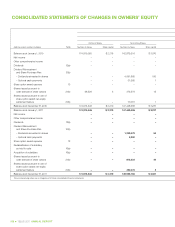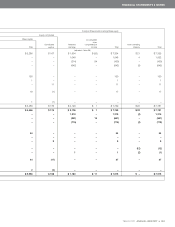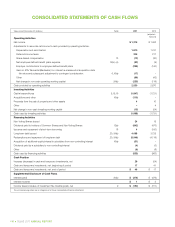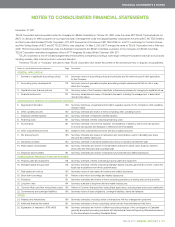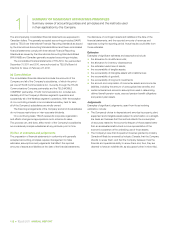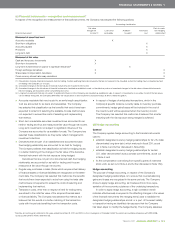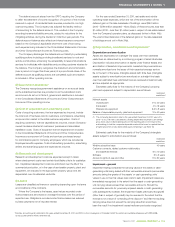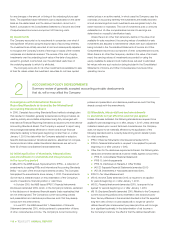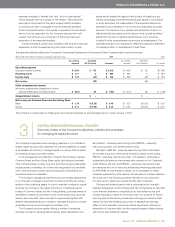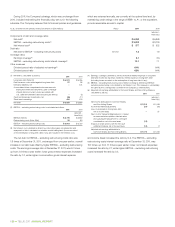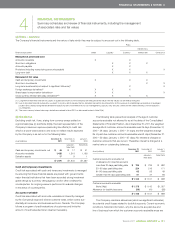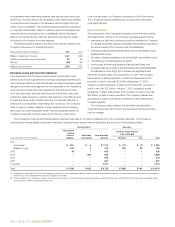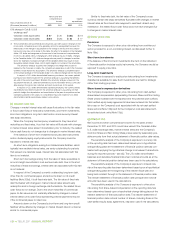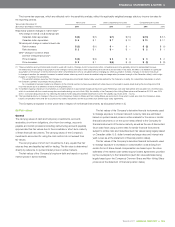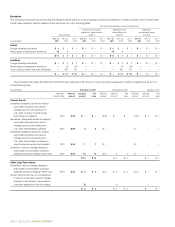Telus 2011 Annual Report Download - page 122
Download and view the complete annual report
Please find page 122 of the 2011 Telus annual report below. You can navigate through the pages in the report by either clicking on the pages listed below, or by using the keyword search tool below to find specific information within the annual report.
118 . TELUS 2011 ANNUAL REPORT
for any changes in the amount or timing of the underlying future cash
flows. The capitalized asset retirement cost is depreciated on the same
basis as the related asset and the discount accretion, as set out in
Note 8, is included in the Consolidated Statements of Income and Other
Comprehensive Income as a component of Financing costs.
(s) Investments
The Company accounts for its investments in companies over which it
has significant influence using the equity basis of accounting whereby
the investments are initially recorded at cost and subsequently adjusted
to recognize the Company’s share of earnings or losses of the investee
companies and dividends received. The excess of the cost of equity
investments over the underlying book value at the date of acquisition,
except for goodwill, is amortized over the estimated useful lives of
the underlying assets to which it is attributed.
The Company accounts for its other investments as available-for-sale
at their fair values unless the investment securities do not have quoted
market prices in an active market, in which case the Company uses the
cost basis of accounting whereby the investments are initially recorded
at cost and earnings from such investments are recognized only to the
extent received or receivable. The cost of investments sold or amounts
reclassified out of other comprehensive income into earnings are
determined on a specific identification basis.
Unless there is an other than temporary decline in the value of an
available-for-sale investment, the carrying values of available-for-sale
investments are adjusted to estimated fair values with such adjustment
being included in the Consolidated Statements of Income and Other
Comprehensive Income as a component of other comprehensive income.
When there is an other than temporary decline in the value of an invest-
ment, the carrying values of investments accounted for using the
equity, available-for-sale and cost methods are reduced to estimated
fair values with any such reduction being included in the Consolidated
Statements of Income and Other Comprehensive Income as Other
operating income.
2ACCOUNTING POLICY DEVELOPMENTS
Summary review of generally accepted accounting principle developments
that do, will or may affect the Company
Convergence with International Financial
Reporting Standards as issued by the International
Accounting Standards Board
In 2006, Canada’s Accounting Standards Board ratified a strategic plan
that resulted in Canadian generally accepted accounting principles, as
used by publicly accountable enterprises, being fully converged with
International Financial Reporting Standards as issued by the International
Accounting Standards Board. The Company is required to report using
the converged standards effective for interim and annual financial
statements relating to fiscal years beginning no later than on or after
January 1, 2011, the date which the Company selected for adoption.
Specific disclosures about transitional elections, adjustment of compara-
tive amounts and other related transitional disclosures are set out in
Note 25 of these consolidated financial statements.
(a) Initial application of standards, interpretations
and amendments to standards and interpretations
in the reporting period
In May 2010, the IASB issued Improvements to IFRSs – a collection of
amendments to existing IFRSs and International Accounting Standards
(IASs) – as a part of the annual improvements process. The Company
has applied the amendments since January 1, 2010. The amendments
did not have a material impact on the presentation of the Company’s
results of operations, financial position or cash flows.
In October 2010, the IASB issued IFRS 7, Financial Instruments:
Disclosures (amended 2010), which, in the Company’s instance, pertained
to the disclosure of transferred financial assets (trade receivables) that
are not derecognized. The Company’s current accounting policies
and presentation and disclosure practices are such that they already
comply with the amendments.
In June 2011, the IASB issued IAS 1, Presentation of Financial
Statements (amended 2011), which pertained to presentation of items
of other comprehensive income. The Company’s current accounting
policies and presentation and disclosure practices are such that they
already comply with the amendments.
(b) Standards, interpretations and amendments
to standards not yet effective and not yet applied
Unless otherwise indicated, the following standards are required to be
applied for periods beginning on or after January 1, 2013. Unless otherwise
indicated, based upon current facts and circumstances, the Company
does not expect to be materially affected by the application of the
following standards and is currently determining which date(s) it plans
for initial compliance.
.IFRS 7, Financial Instruments: Disclosures (amended 2011).
.IFRS 9, Financial Instruments, is required to be applied for periods
beginning on or after January 1, 2015.
.Other than for the disclosure requirements therein, the following stan-
dards and amended standards must be initially applied concurrently:
.IFRS 10, Consolidated Financial Statements
.IFRS 11, Joint Arrangements
.IFRS 12, Disclosure of Interests in Other Entities
.IAS 27, Separate Financial Statements (amended 2011)
.IAS 28, Investments in Associates (amended 2011).
.IFRS 13, Fair Value Measurement.
.IAS 12, Income Taxes (amended 2011), is required to be applied
for periods beginning on or after January 1, 2012.
.IAS 32, Financial Instruments (amended 2011), is required to be
applied for periods beginning on or after January 1, 2014.
.IAS 19, Employee Benefits (amended 2011): Relative to the Company’s
current accounting policies and presentation and disclosure prac-
tices, the key difference in the amended standard is that the expected
long-term rate of return on plan assets will no longer be used for
defined benefit plan measurement purposes (and thus will no longer
be a significant estimate). In the determination of net income in
the Company’s instance, the effect is that the defined benefit plan


